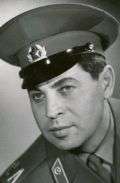Alexandrov Ensemble
Alexandrov Ensemble is an official army choir of the Russian armed forces. Founded during the Soviet era, the ensemble consists of a male choir, an orchestra, and a dance ensemble.
Alexandrov Ensemble, along with the MVD Ensemble, are the only groups with the right to claim the title "Red Army Choir" .
The Alexandrov Ensemble has entertained audiences both in Russia and throughout the world, performing a range of music including folk tunes, hymns, operatic arias, and popular music. The group's repertoire has included The Volga Boatmen's Song, Katyusha, Kalinka, and Ave Maria.
The ensemble is named for its first director, Alexander Vasilyevich Alexandrov (1883-1946). Its formal name since 1998 is Academic Ensemble of Song and Dance of the Russian Army named after A. V. Alexandrov (Russian: Академический ансамбль песни и пляски Российской Армии имени А. В. Александрова, Akademichesky ensemble pesni i plyaski Rossiyskoy Armii imeni A. V. Alexandrova),[1] shortened to Academic Ensemble (Russian: Академический ансамбль, Akademichesky ensemble)[1] on second reference.
History
Under Alexander Vasilyevich Alexandrov
.jpg)
Early Years
Born into a peasant family, Alexandrov became the first artistic director of the ensemble, choirmaster, conductor, teacher and the public figure who wrote the music to the National Anthem of the Soviet Union.[2] He came from a musical background of hymns and folk songs, could play the viola and had perfect pitch, so he sang in the church choir and performed at festivals. He was heard singing at the village school by PA Zalivuhin, a soloist in the choir at Kazan Cathedral, St. Petersburg. Zalivuhin persuaded Sacha's parents to let the child go to St Petersburg to learn music. In 1898, the young peasant boy became a pupil of the very grand Court Chapel (now the State Academic Chapel of St Petersburg Glinka).[2][3]
The Ensemble
Beginnings
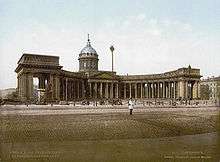
There are two recorded histories of the Ensemble: possibly separate elements of the same history. The first says that the initiator of the Ensemble was Felix Nikolaevich Danilovich, a theatre director. The first director of the Ensemble was chosen from three of Moscow's conductors: Danilin, Chesnokov and Alexandrov. Seen in isolation this would signify that A.V.Alexandrov was not the creator of the Ensemble. In this version the first troupe is named as follows. Singers: Tkachenko, Zyukov, Samarin,Rozanov, Koltypin, Tolskov, Golyaev, Charov. Dancers: Maximov, Svetlov. Bayanist: Surdin.[4]
The second version says that the Ensemble was formed out of the Frunze Red Army Central House in 1928. There is also a story that Stalin then asked Alexandrov to relocate the choir to Moscow.[2] Under the name Red Army Song Ensemble of the M. V. Frunze Red Army Central House, shortly the "Red Army Choir", twelve soldier-performers - a vocal octet, a bayan player, 2 dancers, and a reciter - officially performed for the first time on October 12, 1928 under the direction of their conductor, Alexandr Alexandrov, a young music professor at the Moscow Conservatory. The program, entitled The 22nd Krasnodar Division in Song, consisted mainly of short musical scenes of military life, including Songs of the First Cavalry Army, The Special Far-Eastern Army, and Song about Magnitostroi.
Development
In 1929, the ensemble visited the far eastern lands of the Soviet Union, entertaining the troops working on the Far Eastern railway.
With the goal of developing amateur art within the ranks of the army and to encourage soldiers' interest in good music, the ensemble grew to 300 performers by 1933, comprising three different forces of a male choir, an orchestra, and an ensemble of dancers.[5] The Red Army Choir became known as a propagator of Soviet songs, performing original compositions by composers such as Vasily Solovyov-Sedoy, Anatoli Novikov, Matvey Blanter and Boris Mokrousov.
In 1935, the choir was bestowed the Order of the Red Banner and was renamed the Red Army Red-bannered Song and Dance Ensemble of the USSR.
Having traveled widely throughout the Soviet Union, from the Arctic north to the sands of Tajikistan, the choir performed at the International Exposition dedicated to Art and Technology in Modern Life held in 1937 in Paris, France; it won the Grand Prix, the highest honor bestowed by the jury.
During World War II, the ensemble gave over 1500 performances at both Soviet fronts, entertaining troops about to go into battle, at gun emplacements, airfields, and in hospitals.[3][6][7][8][9]
Under Boris Alexandrovich Alexandrov
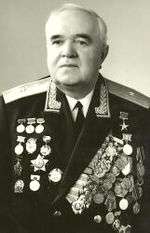
Following the death of Alexander Alexandrov, the Ensemble was taken over by his son, Boris Alexandrovich Alexandrov. Under his leadership, the Ensemble gained fame outside the Soviet Union, making extensive tours worldwide. Boris Alexandrov retired in 1987, and was succeeded by People's Artist of Russia Igor Agafonnikov the same year,[10] with Anatoly Maltsev as the ensemble chief. He retired as the principal conductor in 1994; he died that year and was buried in Moscow at the Novodevichy Cemetery.[11] He was succeeded by Victor Fedorov, the chorus master since 1986.
Under B.A. Alexandrov, the Ensemble was highly disciplined. Boris's party trick was to leave the stage and allow the Ensemble to perform "En Route" alone. Members were positioned so that they could not all watch one orchestral leader, and this appeared to be a trick, but there was no trick at all. Leonid Mikhailovich Kharitonov remembers:
"The Ensemble members were so disciplined and experienced that they could feel the rhythm simultaneously and could sing and play together automatically, without the conductor… In Canada during one concert Alexandrov left the Ensemble to perform alone for half an hour."[12]
Vladimir Alexandrov
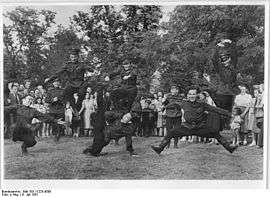
(b. 1910; d.1978). Major Vladimir Alexandrov, brother of Boris Alexandrov (above), also composed for the Ensemble. .[13] He served as Orchestral Director and Conductor .[14]
Other principal conductors
Vladimir Gordeev was the principal conductor on the 1988 UK tour.[15]
Vyacheslav Korobko
Today, the ensemble is led by Honoured Artist of Russia Vyacheslav Korobko, who has been leading it since 2003 .[16]
Collaborations
Over the years, the ensemble has collaborated with many popular artists and producers including David Foster, Jean-Jacques Goldman and Steve Barakatt.
Uniform
Until 1969 the standard uniform for the Ensemble choir, soloists and orchestra was the tunic and riding breeches. On 1 January 1970 this was changed to dress uniform,[17] and there have been further variations to the dress uniform as used by the Ensemble since 1970.
The renaming of the Ensemble
In 1949 the ensemble was officially titled the "Twice Red-bannered and Red-starred Ensemble of Song and Dance of the Soviet Army named after A. V. Alexandrov", so it was no longer called the "Red Army Choir" in brief, but known as "Alexandrov Ensemble.". In 1978 the ensemble was renamed the Twice Red-bannered and Red-starred Academic Ensemble of Song and Dance of the Soviet Army named after A. V. Alexandrov." After the dissolution of the Soviet Union, in 1998 the ensemble got its present name.
Awards for the Ensemble
- For global recognition of high art: The Global Team Award
- From the French Academy of Records, for the best record: Gold Disk (1961)
- From the French company Chant Du Monde, for record sales: Gold disk (1964)
- Order of the Mongolian Combat Merit (1964)
- Czechoslovak Order of the Red Star (1965)
- From the Dutch company N.O.K, for record sales: Gold disk (1974)
- The honorary title of Academy (1979)[10]
Composition
Soloists
- Go to Ensemble soloist page for details of these past and present regular and guest soloists:
Georgi Abramov | Nicolai A. Abramov | Vadim Petrovich Anayev | Georgy I. Andryushchenko | V.I. Anisimov | Georgiy I. Babaev | Evgeny Mikhailovich Belyaev | Piotr Dmitrievich Bogachev | Ivan Semionovich Bukreev | Vladimir Bunchikov | E. Burchak | Victor Sergeievich Buzurov | Dmitry Bykov | Vladimir Chernykh | Tatiana Deryabkina | Boris Diakov | Ivan A. Didenko | V. Dmitriev | Arthur Arturovich Eisen (or Eisenach) | V. Fedorov | Stanislav I. Frolov | Valery Gavva | Konstantin G. Gerasimov | Vladimir P. Gorlanov | Nicholai Timofeyevich Gres | AA Gvozdetsky | Sergei Vasilievich Ivanov | B. Jaivoronok | Vladimir Nikolaievich Katerinsky | Leonid M. Kharitonov | Andrey Kusleev | I. Kuznetsov | Edward Maxovich Labkovsky | V.P. Maystruck | A.I. Mischenko | B.M. Mizyuk | Konstantin Pavlovich Lisovskiy (or Lissovsky, Lisovsky, Lisovski) | Yuseph Laut | A.P. Martynov (or Martin, or Martinov) | V.P. Maystruk | P. Mikhailov | B.M. Mizyuk | Victor Ivanovich Nikitin | V. Pankov | I. Pchenitchni | N.S. Polozkov | Vladimir V. Puchkov | Oleg N. Razumovsky | Mark Reizen | Vadim L. Ruslanov | Victor Sanin | Ivan Ivanovich Savchuk | Alexei Tikhonovich Sergeev | Boris G. Shapenko | Boris Shemyakov | Vladimir Shkaptsov | Vasily Ivanovich Shtefutsa | Alexander Sergeievich Sibirtsev | B. Slastnoi | Anatoly Solovyanenko | A. Syrovatko-Zolotarev | Barseg Tumanyan | Alexei Usmanov | Georgi Pavlovich Vinogradov | Igor F. Volkov | Leonid V. Wheat | Boris G. Zhayvoronok
- These soloists are on the Ensemble soloist page and also have their own pages:
Evgeny Belyaev • Victor Ivanovich Nikitin • Leonid Mikhailovich Kharitonov • Mark Reizen • Georgi Pavlovich Vinogradov
Chorus
Current members of the choir are listed here. The choir consists mainly of vocal sections of tenor, baritone, and bass. In some of the pieces they perform, these sections are divided into as many as eight different vocal lines. From the early 1950s until at least 1965 a typical full division (which varied from song to song) was as follows: (1) countertenors; (2) first tenors; (3) second tenors; (4) baritones; (5) first bass; (6) second bass; (7) basso profundos.[18]
Orchestra
The orchestra, in what became a typical composition for later generations of military ensembles in the Soviet Union, has a mixed composition of Russian traditional instruments and western instruments, including the balalaika, the domra, the bayan, the double bass, woodwinds, brass, and percussion instruments. A great guest balalaika player was Boris Stepanovich Feoktistov (Борис Степанович Феоктистов) (1910–1988). In the West his most famous recording is Kamarinskaya (1963) [19] [20] .[21] A. Molostov is the trumpet soloist in Dark Eyes in vintage recordings .[22] The bayan-player Victor Gridin is a past member of the orchestra .[23] The current members of the orchestra are listed here..
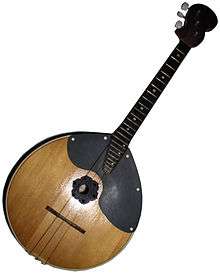
Dancers
Current members of the ballet are listed here. Among the dances staged by the ensemble are Zaparozhtsi Dance, Cossack's Cavalry Dance, Festive March, Dance of the Cossacks, Soldier's Dance, and Sailor's Dance. Some of these are performed by mixed dancers, while others, such as Cossack's Cavalry Dance, are performed by male dancers only.
The Ensemble ballet today
The ballet is under the direction of Lev Nikolaevich Kulikov National Artist of Russia, the main ballet master, and maintains the heights of choreographic art with honour. The priority in its repertoire is taken by the military compositions: Matroskaya barynya, Kazachiya cavalry plyaska, Festive march, Invitation to dance and others. The ballet performs a lot of Russian folk dances. The classical repertoire contains Poloveckie plyasky from the opera Prince Igor written by Alexander Borodin. This is from our dance classics, but we always update the dance repertoire. (Leonid Ivanovich Malev, current Director of the Ensemble, interviewed by Russia Beyond the Headlines Dec 1st 2008) [24]
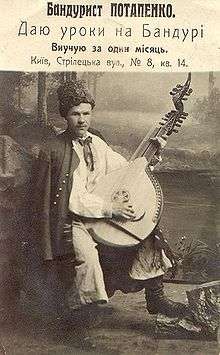
Current leading lights and stars
The artistic director and chief conductor is Honoured Artist of Russia V. Korobko. The chief choreographer is People's Artist of Russia L. Kulikov; the chief administrator is Honoured Artist of Russia VG Kadin, the choreographer and coach is the Honoured Artist of Russia V. Ermolin; head dresser is Honoured Worker of Culture A. Kormilitsyn; soloists are VI Shtefutsa and EM Labkovsky; with SV Ivanov, PD Bogachev, VP Maystruk, AA Gvozdetsky, BM Mizyuk: all Honoured Artist of Russia .[10]
In the choir are YA Lysenko, Y. Shtrunov, IM Pirogov, IS Sobolev, И.Ф. Volkov, OV Filimonov, AN Savitsky, VA Nagorny, VP Kokarev, AA Hristachev, JN Deynekin, VM Bolonenko, VN Antonov, AN Stritenko, AA Toschev: all Honoured Artist of Russia; and VS Buzlov, SP Lapik, VF Orthodox, GU Razgasimov, V. Chekin, MD Mochalina .[10]
In the orchestra are AA Mogulkin, Y. Savkin, MG Chervov, PD Shchennikov, NI Diakov, AI Egorov, VM Predelin: all Honoured Artist of Russia. Vocal coaches are People's Artist of Russia, laureate of competitions, MI Glinka and PI Tchaikovsky, Professor KP Lisovsky. The Principal Concertmaster is Honoured Artist of Russia V. Brodsky .[10]
In the ballet are GD Pavlyuchenko, IV Konygina, P.U. Khmelnitski: all Honoured Artist of Russia.
Composers and directors
- Konstantyn Dankevych (1905–1984): a Ukrainian who was director of Songs and Dance of the Red Army Choir in Tbilisi, and wrote Poem of Ukraine.[25]
- Lev Knipper (1898–1974) who composed Polyushko Pole, and Viktor Gusev (1909–1944) who wrote the lyrics.
- Pavlo Virsky who was artistic director of the Alexandrov Ensemble dancers from 1942, for many years.
- Samuel Pokrass (1897–1939) who wrote White Army, Black Baron or Red Army is Strongest; lyrics by P. Grigoriev.
Repertoire, concerts and tours
The 1948 Berlin Peace Concert

See images here and here. In 1948 much of Berlin was still ruined after World War II, and the city was divided into four occupation zones, controlled by the USSR, France, the UK and the USA. This was before the Berlin Wall, and it was still possible to travel between zones. An American officer suggested a concert in the Gendarmenmarkt (in the Soviet zone at the time), and the French zone commander supported the suggestion. The musicians were to be provided by the USSR, and the Alexandrov Ensemble was chosen. A temporary stage was set up in the square, with flowers all along the front. 30,000 people came to stand and watch for three hours. In 1994, towards the end of his life, Boris Alexandrov said:
"The visit to Germany was unforgettable. It is dominant in the history of the ensemble. It was necessary to make a new creative leap - from wartime military music to postwar relaxing harmony. It was important, and the transition had to be managed on many fronts, including getting the Ensemble back into its original pre-war role, performing the classics and singing folk songs. Before the war the Ensemble had 200 professional singers; following the war it was down to 60."[26]
A previous tour to East Germany had been cancelled due to the sudden death of Alexander Alexandrov in 1946 in Potsdam, when in his bed was found an annotated copy of Beethoven's Symphony No. 9, showing that A. Alexandrov had been preparing the final chorus for a performance. Now Boris, his son, was ready to follow his father's plan. The 1948 peace concert was to consist of German opera extracts and Russian folk songs (Nightingales, Zemlyanka and Roads); and after an intervention by the tenor Victor Nikitin, some German folk songs were also included. The people joined in, singing Heidenröslein, and Nikitin sang Kalinka three times in a row. The concert was very successful, and very moving. [27] [28][29] A sound recording clip (link) of the concert was made, and pressed in 1985 under the Radio DDR 1 label. This is listed on the Alexandrov Ensemble discography page.
However the Berlin Peace Concert did not happen in isolation. It was part of a series of punishing yearly tours to war-torn areas. The main tour season during and just after World War II appears to have run from June to October - perhaps because the large troupe usually had to perform outdoors, to accommodate large audiences. The August 1948 Berlin concert occurred two-thirds of the way through a tour to (20 June to 18 July) Prague, Most, Brno, Devin, Bratislava, Moravská Ostrava, Žilina and Kosice in Czechoslovakia; then apparently without a break (18 July to 10 October) Dresden, Weimar, Magdeburg, Stendal, Schwerin, Potsdam, Berlin, Rathenow, Leipzig, Halle, Lane, Erfurt, Chemnitz, Frankfurt an der Oder and Schwarzenberg in Germany [30] .[31]
Films
The Ensemble under the direction of Boris Alexandrov can be heard singing It's a Long Way to Tipperary in the 1981 film Das Boot. Several films have been made of the Ensemble's performances: see Alexandrov Ensemble discography.
The Wall Concert
In 1990, the ensemble participated in Roger Waters' The Wall concert celebrating the fall of the Berlin Wall. They performed an anti-war song, Bring the Boys Back Home.
The repertoire today
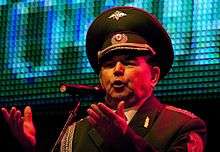
In 2006 and 2007, in Moscow and in Vladikavkaz, Grozny, the Ensemble performed a New Year fairy tale show for children, Ivan the Good, Ivan the Brave, about a soldier helping to save New Year's Day .[32]
In 2008, the 80th anniversary of the Ensemble, the Director said this:
Of course everything depends on the repertoire which is quite large - more than two thousand works. Depending on the concert we choose a special repertoire. We have a rule that we try not to break. In any country we sing 2-3 songs in the native language of the people who live there. As a rule it helps to find a rapport with, and the appreciation of, the audience. And for us it is some kind of musical gift, to honour the host country and its people. For instance in Canada when we sang the National Anthem of Russia people stood up to show respect to our country, and when we finished we sang their country's anthem Oh, Canada!.
A million people in our country and abroad like songs like Kalinka, Katyusha, Smuglyanka and the other songs of the military years as well as The Day of the Victory, Dark Eyes, Vecherny zvon and Podmoskovnye vechera. All these songs are known because of the Alexandrov folk song and dance company and people want to hear these songs at every concert. They are not just part of our history; they are great masterpieces. It is interesting that Svyaschennaya Voyna, written by Alexander Vasilyevich Alexandrov in 1941, helped Soviet soldiers to protect their Motherland and is still popular in Slovakia, Poland and Bulgaria. Those audiences listen to it standing up and it touches their hearts and souls.
For our concerts we search for new musical works because you can't live only in the past. But to tell you the truth it’s impossible to imagine our concerts without works of Russian and West-European classical music (Beethoven, Bach, Tchaikovsky and Mussorgsky), they are part of human history. But our repertoire contains not only songs of the military years and folk songs, arias from operas, songs of the world and spiritual music but also new songs such as Iliya Reznik's To Serve Russia, and those written by Eduard Hanka, Kim Breytburg, Sergey Sashin and other modern composers and poets.
Current Director of the Ensemble Leonid Ivanovich Malev, interviewed by Russia Beyond The Headlines, 1 December 2008 [32]
The Children's Choir School
"A choir school for children opened recently under the auspices of the Ensemble. It's not a secret that the more you work with children, the greater their prospect of achievement in society. We approached the Ministry of Defence with an appeal to organize this choir and it was approved. October 1st 2007 was the opening day of the Aleksandrovcy creative school for musical and aesthetic education for children. This became an important event in the year of the Ensemble's 80th anniversary.
The first night of the boys' Aleksandrovcy Choir on December 26th at the Cadets' Gold Epaulette Ball went like clockwork. After that night they participated in many concerts. The latest was on Poklonnaya Hill in memory of the Beslan tragedy, as part of City Day on the 3rd and 7th of September. It should be mentioned that we have an excellent director of the school Nina Anatolievna Putilina who puts all her soul into raising this worthy generation. We do a lot in order to raise the new generation with regard to physical, spiritual and moral health. Here children begin at the beginning of vocal music and literary speaking; they absorb the best practice of their teachers. The children's choir has become an integral part of the Ensemble's life and takes part in its important concerts. We plan to have tours together."
Director of the Ensemble Leonid Evanovich Malev, interviewed by Russia Beyond The Headlines, 1 December 2008 [32]
International acclaim
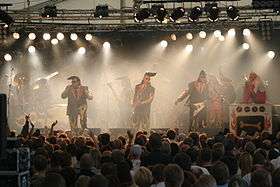
In 1993 the ensemble became an item of pop culture by performing together with the Finnish cult band Leningrad Cowboys both in Helsinki, Finland where they performed on the Senate Square in front of 70,000 ecstatic listeners, and in Berlin. In the German capital the concert of the Leningrad Cowboys with the ensemble took place on the central Lustgarten and gave the former Red Army's farewell to Berlin and the whole Germany an optimistic overtone. The Finnish concert was made into a rockumentary Total Balalaika Show by film director Aki Kaurismäki. That year they also made a CD and played a concert with French singer Jean-Jacques Goldman. The Ensemble and the Leningrad Cowboys performed Sweet Home Alabama at the 1994 MTV Video Music Awards.
Reviews
- 1989 "Red Army Ensemble Offers" etc.: J. Rockwell, New York Times
- 2008 "Russia Beyond the Headlines": Canada tour
- Voce del leone webpage: Review of EMI Classics CD: Red Army Ensemble
- Musicweb International CD review of EMI Classics 3 92031 2
See also
References
- 1 2 Академический ансамбль песни и пляски Российской Армии имени А. В. Александрова (Russian)
- 1 2 3 Ensemble-Aleksandrova: Biography of Alexander Alexandrov
- 1 2 Ensemble-Aleksandrova: Biography of A. Alexandrov with dates
- ↑ Prague National Library
- ↑ Some sources say that in 1933 there were 19 members; in 1935 there were 135 and in August 1937 in Paris and Prague they were 150.
- ↑ Geraldika.org webpage: Biography of A. Alexandrov by his grandson Evgeny A. 2008
- ↑ Belcanto.ru webpage: Biography of A.V. Alexandrov
- ↑ Dosie.com webpage: Biography of AV Alexandrov and BA Alexandrov
- ↑ Translated peoples.ru webpage: biog of A. Alexandrov.
- 1 2 3 4 5 Ensemble-Aleksandrova: Biography of Boris Alexandrov
- ↑ Translated Warheroes webpage: biog of Boris Alexandrov
- ↑ Information from Leonid Mikhailovich Kharitonov, October 2009.
- ↑ Translated Japanese webpage: re Vladimir Alexandrov
- ↑ Details from booklet supplied with EMI CD Soviet Army Chorus & Band CDC-7-47833-2.
- ↑ Information from Prism VHS video packaging: see Alexandrov Ensemble discography page.
- ↑ Ensemble-Aleksandrova webpage: Korobko mentioned at bottom of page
- ↑ Information from Leonid Mikhailovich Kharitonov, who was a member of the Ensemble 1953-1972
- ↑ Information from Leonid Mikhailovich Kharitonov, who was a choir-member of the Ensemble 1953-1965. This reference is to be updated to an external link in a few days.
- ↑ CD: EMI: Soviet Army Chorus & Band, CDC-7-47833-2 DIDX-1015, "Kamarinskaya".
- ↑ CD: EMI Classics: Red Army Ensemble, 0946-3-92030-2-4, "Kamarinskaya".
- ↑ Boris Feoktistov playing Karmarinskaya on YouTube
- ↑ CD: Silva Classics: The Best of the Red Army Choir, SILKD6034, "Dark Eyes".
- ↑ CD Review: Victor Gridin (1997)
- ↑ Russia Beyond The Headlines: Interview: Malev 2008
- ↑ This is presumably a different composition from that credited to A. Alexandrov (see Alexandrov Ensemble soloists page.
- ↑ The newspaper "Culture": Pastoral on the Ruins, by Anatoly Kompaniets, 2000. In Russian
- ↑ The newspaper "Culture": Pastoral on the Ruins, by Anatoly Kompaniets, 2000. In Russian.
- ↑ The newspaper "Culture": Pastoral on the Ruins, by Anatoly Kompaniets, 2000. Translated Russian→English.
- ↑ A backup source for Anatoly Kompaniets, "Pastoral over the ruins", p.9 in Russian
- ↑ Alexandrov Ensemble webpage: list of tour dates (links) In Russian
- ↑ Alexandrov Ensemble webpage: list of tour venues 1948. In Russian
- 1 2 3 Russia Beyond the Headlines: Interview: Malev 2008
External links
| Wikimedia Commons has media related to Alexandrov Ensemble. |
- Академический ансамбль песни и пляски Российской Армии имени А. В. Александрова (Russian)
- European Homepage of the Academic Ensemble (Russian, German, French, English)
- VOR Article celebrating 75th anniversary of Alexandrov Ensemble (English)
- Red Army Chorus album review, including history of Ensemble (English)
- Russia Beyond the Headlines: Interview with Leonid Malev 2008
- Translated Sovmusic.ru webpage: Biog. of AV Alexandrov and list of early tracks recorded by Ensemble.
- Rg.ru webpage: interview with Ensemble director Leonid Maleev, by Yadviga Yuferova, 2007 In Russian.
- Translated vpk-news.ru webpage: interview with Ensemble director Leonid Maleev, by Vadim Udmantsev, 2004.
- The newspaper "Culture": Pastoral on the Ruins, by Anatoly Kompaniets, 2000. In Russian.
- Wordpress: Alexandrov Ensemble blog
|
